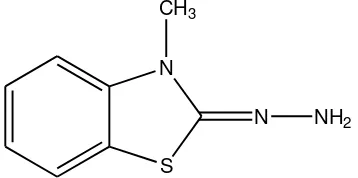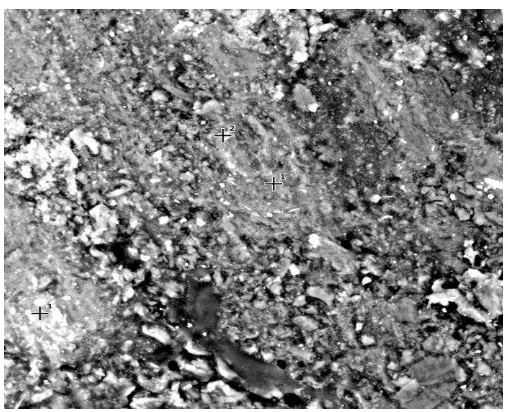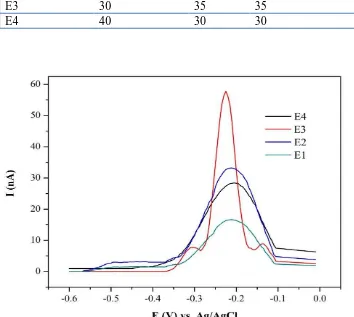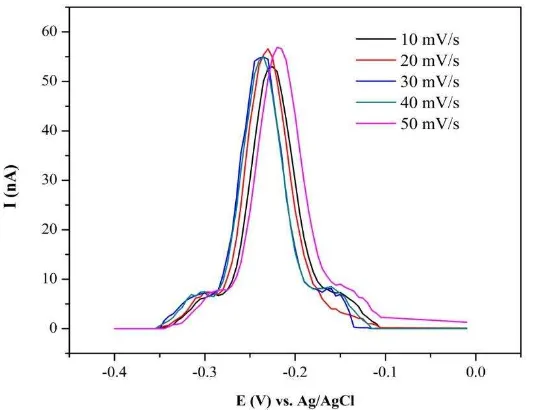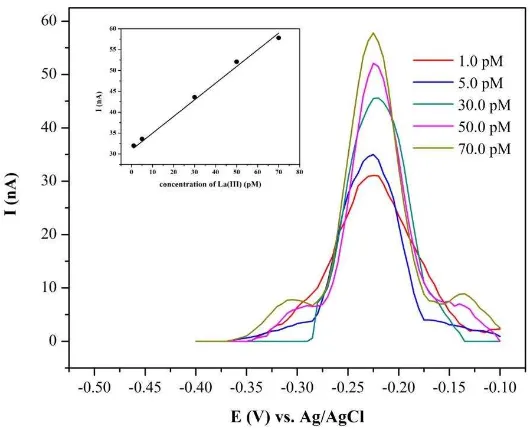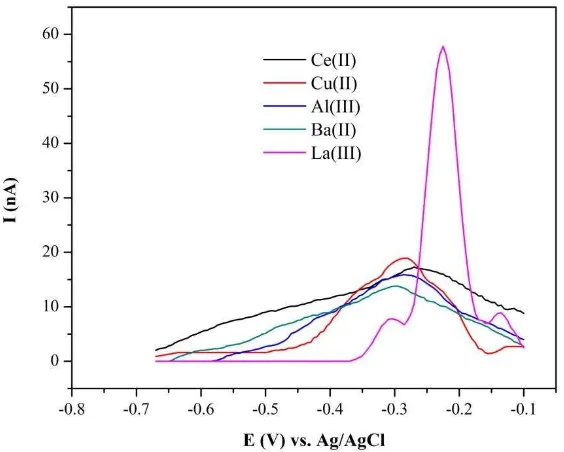Int. J. Electrochem. Sci., 9 (2014) 7763 - 7772
Deparment of Chemistry Education, Faculty of Mathematics and Natural Science, Yogyakarta State University, Indonesia
2
Nanotechnology Research Centre, Faculty of Science and Mathematics, Universiti Pendidikan Sultan Idris, 35900 Tanjong Malim, Perak, Malaysia
*
E-mail: suyanta@uny.ac.id
Received: 11September 2014 / Accepted: 20 October 2014 / Published: 28October 2014
A novel carbon paste electrode modified with 3-methyl-2-hydrazinobenzothiazole (MBTH) was developed for the determination of La(III) by differential adsorptive stripping voltammetry. The best overall performance was shown by an electrode with a composition ratio of MBTH : graphite : paraffin at 30 : 35 : 35 (% w/w) respectively. The performance of the electrode was found in the pH range of 6.0–8.0 and the the scan rate of 50 mV/s at temperature 25±3 ◦
70.0 pM La(III) with a limit of detection 1.0 pM. A life time of electrode more than 3 months was obtained. The modified electrode showed high selectivity, sensitivity, and good reproducibility. The developed method was also applied to determination of lanthanum ion in sand samples.
Keywords: Modified carbon paste electrode, La(III), 3-methyl-2-hydrazinobenzothiazole ligand, differential adsorptive stripping voltammetry
1. INTRODUCTION
Recently, rare earth elements (REE) have garnered considerable attention due to their unusual spectroscopic characteristic for advanced new materials [1,2]. Among REE, lanthanum is the most importance as it is usually applied in high-tech industry, such as super alloys, catalyst [3], special ceramics, and in organic synthesis [4]. Lanthanum is widely distributed in low concentrations about
8 3 / ( ) u u ’ u [5] B u d d
The analytical methods which have been applied to determine lanthanum include graphite furnace atomic absorption spectrometry (GF-AAS) [6], spectrophotometry [7], inductively coupled plasma-atomic emission spectrometry (ICP-AES) [8], inductively coupled plasma-mass spectrometry [9-11], and ion-selective electrodes [5, 12-14]. However, most of these methods required sample pretreatment procedures and not sufficiently sensitive for trace determination of lanthanum. Therefore, the development of a direct method, easy operation, and high sensitivity method are highly desired.
Adsorptive stripping voltammetry (AdSV) has been known as powerful electroanalytical method, providing efficient and high sensitivity for measurement numerous metals and organic analytes at ultratrace concentration level due to the ability to preconcentrate the analyte on the electrode surface [15-18]. Mercury electrodes have been proven to be the most suitable working electrode in stripping voltammetric measurement over the past 70 years [19,20]. Due to the toxicity of mercury and problem associated hazardous waste disposal, some other electrodes have been developed over the last two decades. The modified carbon paste electrode can be suitable working electrodes to
u y’ x b u b k u d u , d
window, non-toxic, and low cost [21-23]. Only a few studies of modified carbon paste electrode have been reported on the detection of lanthanum [24].
Organic ligands have been widely used to modify carbon paste electrode because most of them contain N- and S-based complexing center [25]. It is well known that N- and S-based ligands coordinated selectively with transition and heavy metals [14]. The 3-methyl-2-hydrazinobenzothiazole (MBTH) ligand also contains N- and S-based complexing center which can be suitable for formation complexes with La(III). Therefore, we developed an effective, simple, and sensitive differential adsorptive stripping voltammetry for the determination of La(III) in real samples.
3-methyl-2-hydrazinobenzothiazole hydrochloride (MBTH) (Merck), potassium chloride (Merck), nitric acid (Merck), and potassium nitrate (Merck) were used as received. Stock solutions of lanthanum
S N
N NH2
ion were freshly prepared by dissolving appropriate amount of lanthanum(III) chloride in distilled deionized water. The sample of monazite sands were found from Bangka Belitung Province, Indonesia.
2.2. Equipments
The differential adsorptive stripping voltammetry was performed with EDAQ Potentiostat, (Australia). All experiments were carried out in a single compartment electrochemical cell with a carbon-paste working electrode, a saturated Ag/AgCl reference electrode and a Pt wire counter electrode. These electrodes were immersed in 40 mL buffer solution (also as supporting electrolytes) at various pH and known amount of La(III) solution. The pH value was determined using glass electrode Orion 915600, USA. The morphology of modified electrode was observed by using High Resolution Field Emission (Hitachi, SU 8020 UHR). The validity of the sensor was tested using Varian 715-ES ICP-OES (Australia).
2.3. Preparation of electrode
The modified carbon paste electrodes were a homogenized mixture of graphite powder with modifier, 3-methyl-2-hydrazinobenzothiazole hydrochloride (MBTH), and solid paraffin in different composition until uniform paste. The modified carbon paste electrodes were packed firmly into Teflon tubings (id = 4 mm). Electrical contact to paste was established via a copper wire at one end of tubing. While the other end acted as disc electrode. Before measurement, the disc electrode was smoothened on a piece of weighing paper.
3. RESULT AND DISCUSSION
3.1. Characterization of MBTH modified CPE
Figure 2 shows the differential adsorptive stripping voltammograms of unmodified CPE and
B H d d PE × -11
Figure 2. Differential adsorptive stripping voltammograms of unmodified CPE and MBTH modified
PE d × -11
M La(III) in the presence of 0.5 M KCl, at pH of 7.32 and scan rate 50 mVs-1.
Figure 3. Scanning electron microscope image MBTH modified CPE.
3.2. Effect of carbon paste composition
concentration of MBTH was higher than 30%. This was presumably due to the reduction of conductive area at the electrode surface [19]. Therefore, the composition of 30:35:35% (w/w) was used in subsequent studies.
Table 1. The composition of MBTH modified CPE
Electrode MBTH Graphite Paraffin
E1 10 45 45
E2 20 40 40
E3 30 35 35
E4 40 30 30
Figure 4. Adsorptive stripping voltammograms obtained using four different composition of MBTH
d d PE × -11
M La(III), 0.5 M KCl, at pH of 7.32 and scan rate 50 mV s-1.
3.3. Effect of pH
The effect of pH of the preconcentr u B H
d d PE ud d 8 × -11
M La(III). Figure 5 shows the effect of pH on the anodic peak current of La(III). As can be seen, the peak potential of
Figure 5. Ad × -11 M La(III) at MBTH modified CPE in 0.5 M KCl, a H 8.0 at scan rate 50 mV s-1.
3.4. Effect of scan rate
F u d × -11
M La(III) at different scan rate (from 10 to 50 mV s-1). The anodic peak current increased and the peak potentials shifted to less negative values with increasing scan rate. This indicates the kinetic limitation in electrochemical reaction of La(III) at MBTH modified CPE [26]. Therefore, the scan rate of 50 mV s-1 was used for all subsequent measurement.
Figure 6. Effect of varying the scan rate on the adsorptive stripping voltammograms of MBTH
d d PE × -11
3.5. Linear range, Detection limit, and Reproducibility
Under the optimized conditions, the concentration dependence of La(III) on the performance of MBTH modified CPE was studied. Figure 7 shows the adsorptive stripping voltammograms of the MBTH modified CPE towards La(III) at different concentrations. It can be seen that the anodic peak current linearly increases in La(III) concentration over the range of 1.0 pM 70.0 pM with a correlation coefficient (R2) of 0.9848 and slope of 0.3906. The detection limit was found to be 1.0 pM La(III). The MBTH modified CPE showed good reproducibility for seven successive measurements with same modified electrode, as shown in Figure 8.
Figure 7. Adsorptive stripping voltammogram and calibration curve for La(III) on MBTH modified CPE.
Figure 8. Adsorptive stripping voltammogram of seven measurement on MBTH modified CPE in
× -11 ( ), 5 , H
3.6. Interference study
The selectivity of MBTH modified CPE was evaluated by adding some possible interfering
ud B ( ), A ( ), ( ), d u( ) u 7 × -11
M La(III) under optimized conditions. Figure 9 shows voltammetric response in the presence of interfering ions. It can be seen that they have no influence on the detection of La(III).
Figure 9. Influence of the presence of interfering ions on determination of La(III) by adsorptive stripping voltammetry. The measurements were performed in 0.5 M KCl, pH 7,32, scan rate 50 mV s-1.
3.7. Analytical application
In order to evaluate the performance of the MBTH modified CPE, the determination of La(III) ions in different monazite sand samples obtained from Bangka Belitung was carried out under the optimized conditions. Table 2 shows that the results obtained by the proposed sensor and that of ICP-OES. The quantity of La(III) in the sand samples by the proposed agreed well with those found by ICP-OES. Therefore, this proposed method could be sufficient for determination of La(III) in real samples.
Table 2. Determination of La(III) ion in sand samples using developed electrode and ICP-OES.
Method Samples
Sample 1 Sample 2 Sample 3
Proposed method (ppm) 1.06 ± 1.27 ± 4 1.47 ±
4. CONCLUSION
In this work, the highly sensitive electrochemical sensor for determination of La(III) was successfully developed. The MBTH modified CPE offers attractive properties compared to previous studies such as very low detection limit, simplicity of electrode preparation, and good reproducibility. This sensor showed high selectivity for La(III) determination, even in the presence of other metal ions. The developed sensor was applied successfully for the determination of La(III) ion in the sand samples.
ACKNOWLEDGEMENTS
The authors would like to thank the Directorate General of Higher Education, Ministry of National Education, Indonesia and Yogyakarta State University for financial supports. The author also thank to Prof. Gustan Pari, Prof. Dwi Y, Jaslin Ikhsan, Ph.D, and Miss Tanti Hidayah for precious
4. P. Ramakul, U. Mooncluen, Y. Yanachawakul, N. Leepipatpiboon, J. Ind. Eng. Chem., 18 (2012) 1606.
5. V.K. Gupta, S. Jain, S. Chandra, Anal. Chim. Acta, 486 (2003) 199.
6. A. Skroce, M. McCormick, B. Meehan, V. Dolic, K. Peverill, Spectrochim. Acta, Part B, 48 (1993) 1639.
7. V.K. Jain, A. Handa, S.S. Sait, P. Shrivastav, Y.K. Agrawal, Anal. Chim. Acta, 429 (2001) 237. 8. Y.K. Agrawal, P. Shrivastav, Talanta, 44 (1997) 1307.
9. E. Fujimori, T. Hayashi, K. Inagaki, H. Haraguchi, Fresenius J. Anal. Chem., 363 (1999) 299. 10. S. Li, B. Hu, Z. Jiang, P. Liang, X. Li, L. Xia, Environ. Sci. Technol., 38 (2004) 2249.
11. F.A. Aydin, M. Soylak, J. Hazard. Mater., 173 (2010) 669. 12. S. Khalil, Anal. Lett., 36 (2003) 1335.
13. M.R. Ganjali, V. Akbar, M. Ghorbani, P. Norouzi, A. Ahmadi, Anal. Chim. Acta, 531 (2005) 185. 14. M. Akhond, M.B. Najafi, J. Taskhourian, Anal. Chim. Acta, 531 (2005) 179.
15. J. Li, S. Liu, X. Mao, P. Gao, Z. Yan, J. Electroanal. Chem., 561 (2004) 137. 16. S. Legeai, S. Bois, O. Vittori, J. Electroanal. Chem,. 591 (2006) 93.
17. E. Tesarovaa, L. Baldrianova, S.B. Hocevar, I. Svancara, K. Vytras, B. Ogorevca, Electrochim. Acta, 54 (2009) 1506.
18. M. Ghalkhani, S. Shahrokhian, Sens. Actuators, B, 185 (2013) 669.
19. M. Javanbakht, H. Khoshsafar, M.R. Ganjali, P. Norouzi, M. Adib, Electroanalysis, 21 (2009) 1605.
20. B. Sebez, B. Ogorevc, S.B. Hocevar, M. Veber, Anal. Chim. Acta, 785 (2013) 43. 21. P. Norouzi, V. K. Gupta, B. Larijani, M.R. Ganjali, F. Faridbod, Talanta , 127 (2014) 94. 22. N. I. Wardani, I.M. Isa, N. Hashim, S. A. Ghani, Sens. Actuators, B, 198 (2014) 243.
23. A. Pahlavan, V.K. Gupta, A. L. Sanati, F. Karimi, M. Yoosefian, M. Ghadami, Electrochim. Acta, 123 (2014) 456.
25. Š , , A W u , Vy ř , Electroanalysis with Carbon Paste Electrode, Taylor and Francis Group, Boca Raton, 2012.
26. S.M. Ghoreishi, M. Behpur, S. Mazaheri, M. Motaghedifard, Anal. Lett., 46 (2013) 156.
